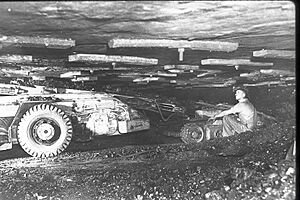Claustrophobia facts for kids
Quick facts for kids Claustrophobia |
|
|---|---|

Getting caught in a small hole, due to cave-ins or suddenly encountering a dangerous animal's den and being unable to defend oneself or retreat, could have caused claustrophobia to become a prepared phobia.
|
|
| Classification and external resources | |
| Specialty | Psychiatry |
| ICD-10 | F40.2.{{{3}}} |
| ICD-9-CM | 300.29 |
| Patient UK | Claustrophobia |
Claustrophobia is a strong fear of being in small or enclosed spaces and feeling like you can't escape. This fear can be set off by many things. Imagine being in a crowded elevator, a room with no windows, a small car, or even wearing clothes that feel too tight around your neck.
This condition is usually seen as an anxiety disorder. It often leads to panic attacks, which are sudden feelings of intense fear. Scientists believe claustrophobia can start for different reasons. These include changes in a part of the brain called the amygdala, learning to fear small spaces through experiences, or even a genetic predisposition (meaning it runs in your family).
Studies show that about 5 to 7 out of every 100 people in the world have severe claustrophobia. However, only a small number of these people get help for it. The word claustrophobia comes from the Latin word claustrum, which means "a shut-in place," and the Greek word phóbos, meaning "fear."
Contents
What are the Symptoms of Claustrophobia?

Claustrophobia usually has two main signs: a fear of being restricted and a fear of not being able to breathe. Someone with claustrophobia might be scared of being trapped in many places. These can include small rooms, locked rooms, cars, airplanes, trains, tunnels, and even elevators. They might also fear caves or underwater spaces.
Sometimes, the fear of being restricted can make people scared of simple things. This could be sitting in a barber's chair or waiting in line at a store. They feel trapped in that one spot. Another place where claustrophobic feelings can happen is in a dentist's chair. This is especially true during dental surgery. Here, the fear is not of pain, but of being held still. Also, having a closed MRI scan can trigger claustrophobia.
Often, when people with claustrophobia are in a small space, they start to worry about not having enough air. They might believe they will suffocate.
How is Claustrophobia Diagnosed?
Claustrophobia is the fear of being unable to escape from a small space. It is an anxiety disorder that can cause severe panic attacks. Sometimes, it is confused with Cleithrophobia, which is the fear of being trapped.
How Do Doctors Measure Claustrophobia?
In 1979, experts created a way to measure claustrophobia. They looked at patient records and scientific papers. After making an early version, other experts tested and improved it. Today, this method uses 20 questions. These questions help figure out how anxious someone is and if they try to avoid certain situations. Many studies have shown this method works well to diagnose claustrophobia.
What is the Claustrophobia Questionnaire?
Two experts, Rachman and Taylor, developed another method in 1993. This method is good at telling the difference between fear of suffocation and fear of being restricted. In 2001, another group of experts made it shorter, from 36 questions to 24. This questionnaire has also been proven very effective in different studies.
How Common is Claustrophobia?
A study from the University of Wisconsin-Madison found that about 5 to 7 out of every 100 people worldwide have severe claustrophobia. However, only a small number of these individuals get any kind of treatment for their fear.
What Causes Claustrophobia?
The fear of enclosed spaces is an irrational fear. This means it's a fear that doesn't make logical sense. Most people with claustrophobia know they are not in real danger when in a room without windows. Yet, they can still feel very afraid, sometimes so much that they can't move. Many don't understand why they feel this way.
The Amygdala and Fear
The amygdala is a very small part of your brain. But it is also very important. It helps create the feeling of fear and the "fight-or-flight response". This response happens when something scary is linked to a bad situation. Some experts believe that phobias, like claustrophobia, start from this fight-or-flight reaction.
One study found that the right amygdala was smaller in people with panic disorders. This can cause unusual reactions to stressful situations. For people with claustrophobia, this means they might panic or overreact when they feel physically confined.
How Learning Can Cause Claustrophobia
Claustrophobia can develop when your mind connects being confined with danger. It often starts after a scary experience from childhood. However, it can begin at any point in a person's life. Such an experience might happen many times, or just once, to leave a lasting mark. Most people with claustrophobia in one experiment said their fear came from a "conditioning experience." This suggests that past events often lead to claustrophobia.
Common Experiences That Can Lead to Claustrophobia
Here are some examples of experiences that could cause claustrophobia in children or adults:
- A child is shut in a dark room and cannot find the door or light switch.
- A child gets stuck inside a box.
- A child is locked in a closet.
- A child falls into a deep pool and cannot swim.
- A child gets lost in a large crowd and is separated from their parents.
- A child puts their head between fence bars and cannot pull it back out.
- A child crawls into a hole and gets stuck, or cannot find their way out.
- A child is left alone in a parent's car, truck, or van.
- A child is in a crowded room with no windows (like a classroom or basement) and has bad experiences with other people, or is put there as a punishment.
Getting a MRI scan can also trigger claustrophobia. An MRI scan requires you to lie still inside a narrow tube for some time. In one study, 13% of patients had a panic attack during an MRI. This procedure can not only trigger existing claustrophobia but also cause it to start in some people. Panic attacks during the scan can stop a person from getting used to the situation, making the fear worse.
S.J. Rachman shared a powerful example involving 21 miners. These miners were trapped underground for 14 days. During that time, six of them died from not having enough air. After they were rescued, ten of the miners were studied for ten years. All but one were deeply affected by the experience. Six of them developed fears of "confining or limiting situations." The only miner who did not show any clear symptoms was the one who acted as the leader.
How is Claustrophobia Treated?
Cognitive Therapy
Cognitive therapy is a common way to treat most anxiety disorders. It is especially helpful for fears where the person isn't scared of the situation itself. Instead, they are scared of what might happen if they are in that situation. The main goal of cognitive therapy is to change wrong or distorted thoughts about what is being feared. The idea is that changing these thoughts will make the anxiety less severe. It also helps people stop avoiding certain situations. For example, cognitive therapy would try to help someone with claustrophobia understand that elevators are safe. It would explain that elevators are actually very useful for getting around faster.
Facing Your Fears: In Vivo Exposure
This treatment method helps people face their fears directly. Patients are gradually exposed to what they are afraid of. It usually starts with small exposures and slowly moves to more intense ones. For instance, a person with claustrophobia might first try riding an elevator. Then, they would work their way up to having an MRI scan.
Other treatments that have also shown good results include psycho-education (learning about your condition), counter-conditioning (learning new responses to fear), regressive hypnotherapy, and breathing re-training. Doctors sometimes prescribe medicines like anti-depressants and beta-blockers. These can help calm the fast heartbeat and other symptoms often felt during anxiety attacks.
See also
 In Spanish: Claustrofobia para niños
In Spanish: Claustrofobia para niños




